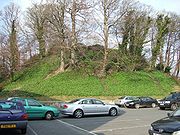
Barnstaple Castle
Encyclopedia

Barnstaple
Barnstaple is a town and civil parish in the local government district of North Devon in the county of Devon, England, UK. It lies west southwest of Bristol, north of Plymouth and northwest of the county town of Exeter. The old spelling Barnstable is now obsolete.It is the main town of the...
, Devon
Devon
Devon is a large county in southwestern England. The county is sometimes referred to as Devonshire, although the term is rarely used inside the county itself as the county has never been officially "shired", it often indicates a traditional or historical context.The county shares borders with...
(. When it was built, it was on the western side of the fortified town and commanded a good view of both the town and its important river crossings.
A wooden castle was built by Geoffrey de Mowbray
Geoffrey de Montbray
Geoffrey de Montbray , bishop of Coutances , a right-hand man of William the Conqueror, was a type of the great feudal prelate, warrior and administrator at need....
, Bishop of Coutances in the 11th century, clearing houses to make room for it. Juhel of Totnes
Juhel of Totnes
Juhel of Totnes was a Breton nobleman and supporter of William I of England of the eleventh century.-Life:He was in 1069 one of the leaders of Breton forces on the Norman side, fighting against the remaining forces that had been loyal to Harold II of England He was Lord of Totnes, and holder of...
(Judhael) later lived in the castle and established a priory
Priory
A priory is a house of men or women under religious vows that is headed by a prior or prioress. Priories may be houses of mendicant friars or religious sisters , or monasteries of monks or nuns .The Benedictines and their offshoots , the Premonstratensians, and the...
just outside its walls. The castle's first stone buildings were probably erected by Henry de Tracey, a strong supporter of King Stephen
Stephen of England
Stephen , often referred to as Stephen of Blois , was a grandson of William the Conqueror. He was King of England from 1135 to his death, and also the Count of Boulogne by right of his wife. Stephen's reign was marked by the Anarchy, a civil war with his cousin and rival, the Empress Matilda...
. In 1228, the Sheriff
Sheriff
A sheriff is in principle a legal official with responsibility for a county. In practice, the specific combination of legal, political, and ceremonial duties of a sheriff varies greatly from country to country....
of Devon had the walls of the castle reduced to a height of 10 feet (3 m). By the time of the death of the last Henry de Tracey in 1274, the castle was beginning to decay. The fabric of the castle was used in the construction of other buildings and by 1326 the castle was a ruin. The remaining walls blew down in a storm in 1601. Now only the tree covered motte remains.

